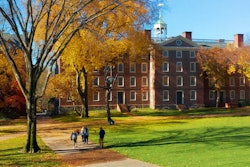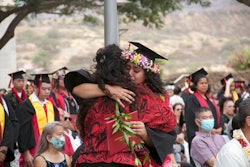Dr. Jason Oliver Chang, associate professor of history and Asian American studies at the University of Connecticut, wanted to check in with his students during the pandemic, so he asked them to write about their experiences.
Students shared stories about food insecurity, family arguments, their gratitude for health insurance, and the little details of their daily lives at home.
“It’s confusing and hurtful to me to have people talk about it as ‘the Chinese Virus’, not knowing what the impact of these words can be to Asian Americans,” an anonymous senior wrote.
“At first, we struggled with both what and how much food can be available to us,” wrote first-year student Tam Vu.
“My father and mother are mid-sixties,” junior Emerson Femc wrote, “so I am trying to do all I can to keep myself contained and them safe.”
Reading students’ responses, Chang had an idea: What if their stories could be turned into art?
 By Simi Kang
By Simi KangIn a new social media campaign called #MyCovid19Semester, the University of Connecticut’s Asian and Asian American Studies Institute selected four Asian American artists to illustrate students’ written narratives about the coronavirus. Each artist chose one student’s story to tell – and the final results were shared online to encourage students from across the country to submit their own thoughts and artwork. The institute plans to share those submissions on social media.
Chang described art as “a process of meaning making” that allows students to learn in new ways. This isn’t the first time he’s brought art into the classroom. Starting in the fall semester of last year, the Asian and Asian American Studies Institute won a three-year grant from the University of Connecticut – the Scholarship and Collaboration in Humanities and Arts Research grant – specifically to incorporate art into their work.
 By Dinh Tran
By Dinh TranIn the past, Chang has had students make collages of archival maps of Asia and areas where Asian diaspora communities lived. This semester, he gave an optional assignment for which students could make zines, connecting their coronavirus experiences to a theme in Asian American history.
“The real learning objective that I’m after with all of the arts-based pedagogy is to ask them to transform their learning in the classroom and with texts into aesthetic choices,” he said. “And by making a cognitive shift between knowledge and aesthetics, it’s a different kind of application that generates different kinds of educational outcomes that have greater meaning for the students.”
For the illustration project, the institute selected Asian American artists Dinh Tran, Simi Kang, Quyen Truong and Szu-Chieh Yun. While not all of the students who submitted narratives were Asian American, many do describe Asian American experiences of the pandemic.
For senior Tamanna Brar, seeing artist Simi Kang’s rendition of her story was “really beautiful,” in part because Kang is a Punjabi artist and Brar is a Punjabi student.
 By Quyen Truong
By Quyen Truong“It actually captured everything I’m going through right now,” Brar said, down to the Indian food her family cooks, her red face mask and the brochure for her mother’s now-closed salon. “Only an artist who shared the same culture as me would actually get it right.”
It moved her and her family to see someone pay that kind of attention to the details of her life during the pandemic, she added. She hopes through the artwork, other people will be able to connect to different facets of her experience, as a South Asian student and as the daughter of a small business owner impacted by the crisis.
“The whole world is kind of going through the same thing,” Brar said. “So, seeing a story or listening to what another person is doing in this time, it’s kind of interesting or it makes you think, ‘Ok, I’m not the only one. There are other people like this.’”
 By Szu-Chieh Yun
By Szu-Chieh YunThe artists were chosen to reflect a variety of artistic approaches, and in doing so, the many identities encapsulated in Asian American communities.
“I wanted that diverse style to reflect diverse voices and experience,” said Dr. Na-Rae Kim, assistant professor in residence and associate director of the Asian and Asian American Studies Institute.
While the #MyCovid19Semester campaign wasn’t the original plan for the grant funds, she hoped the combination of art and social media would inspire students to engage.
In the classroom, she finds that “a lot of students respond really quickly to visual media and social networks,” she said, “so we wanted a platform that students would immediately connect to on a very visceral level.”
She also appreciates that social media makes students’ experiences easy to circulate at a time when students are likely to feel disconnected. It can generate a “newfound community” for them online, she said, one built by students across the country by simply describing their day-to-day lives in different mediums.
“I thought by sharing stories, sharing illustrations, sharing experiences and responses, students can kind of build a big virtual community or virtual connection, even though they’re not on the same campus, not in the same dorms, maybe not in the same institutions,” she said. “But they can feel the things binding them together.”
Sara Weissman can be reached at [email protected].





















